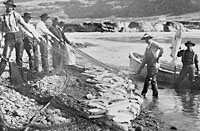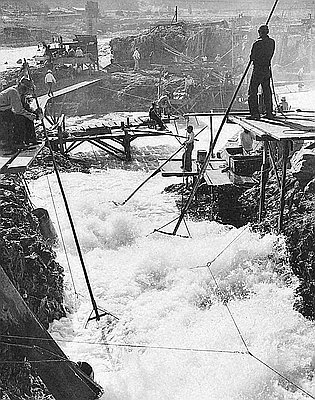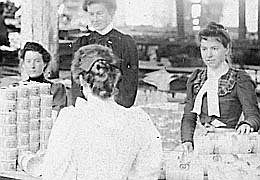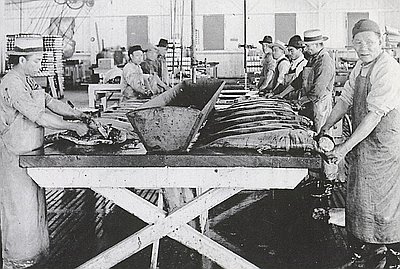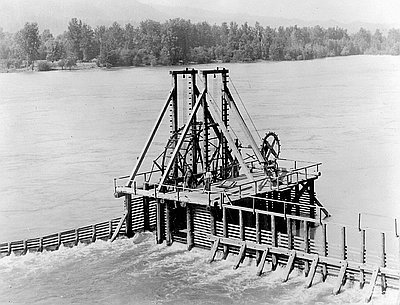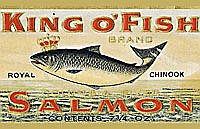The New Western History is not that new anymore. Nonetheless, this collection of images and documents and its accompanying essays on Columbia River canneries remind me that simply looking at underexamined areas of the West—as early New Westers did—still shocks me into realizing how much I do not know and how much pleasure there is in learning more about the West.
Try an experiment. Flip through the images and documents in this collection. Then ask yourself: Did I notice anything that would be associated with traditional histories of the American West? I could not find one selection that does. This collection of essays opens our eyes to what we have not bothered to see and pushes us to connect the present to a western past that is, in some ways, disturbing but is also thick with meanings and rich in human experience.
As a starting point for this project, the Oregon Historical Society chose an iconic symbol of the Pacific Northwest—fish. Many of us know the significance of salmon to the cultures and history of the Pacific Northwest and would agree that the trade in salmon has remained important to the region’s economy. With a bit more exposure to the area’s history, we would all nod that, yes, following the evolution of salmon fishing would teach us plenty about changes in the Columbia River Basin during the past century and a half. I recently learned, for example, that at the time of white contact, the Nez Perces—only one of many groups drawing on the Columbia River’s bounty—probably gathered close to three million pounds of salmon annually, equaling more than five hundred pounds per person.
It is not such general observations that continue to rattle me, but instead particular frozen moments that have luckily been preserved and later trotted out. I see Chinook fishermen taking a break from seining to pose with a baseball and a catcher’s mitt and vest; dueling political advertisements between fishwheelers and gillnetters; a chart of the lower Columbia River, densely coded according to various means of drawing down legendary salmon migration, including pound nets, fishwheels, seines, and gillnets; a slightly scary sequence showing huge logs churning downstream from a busted dam; and picnicking Finnish socialists. My first response is probably like that of many others. Huh?
That reaction is at the heart of how historians and the public met the fresh approaches and challenging ideas that had such an impact on western history thirty years ago. It was not so much the new methodologies, the new conceptual frameworks, and the applications of new questions from other fields that comprised the new approach to history. At the base of that approach was the exhilarating realization that there was so much in the western past that was just sitting there, waiting for us to see, pushing us to ask the only question that lovers of history ever really ask: What was going on here?
The collection of documents from the Oregon Historical Society presented here provokes that question over and over again. I remembered a tape I saw of a talk by David McCullough, who described an exercise meant to engage his students through the simple act of piquing their inherent curiosity. He gave each student a photograph or other type of image. Everything from the OHS collection would have qualified. On the back of each image, he wrote the simplest identification. Form these images, the identification might be “Indian dipnetters fishing for salmon near a fishwheel at Celilo Falls, c1900” or “Labels for canned salmon, c1860s-c1910.”
The student’s assignment was to start with that spare information, find out all that he or she could, explore the meanings and context and implications of the image, and then to produce a paper or some other presentation. Starting with the image of Indian dipnetters, that process might mean an exploration of the role of salmon in Native economies, or of the tortured history of Celilo Falls, or even of the evolving uses of flowing water in human subsistence. Beginning with the labels, one might explore the rise of industrial fishing, or the uses of Pacific icons in the first years of modern advertising, or canning itself and how we have disguised the fact that we are buying processed animals inside metal coffins.
McCullough’s charge was to look at something foreign, odd, and puzzling, and to ask obvious questions. The point was to engage the human impulse to understand how an image from some distant time might explain itself and say something meaningful to us today. By engaging that impulse, McCullough’s hope was to shake awake what draws many of us to history—the paradox that the past is a profoundly strange place that we can approach because, to some degree, we can know and identify with the women and men who look and speak at us across the void through photographs, documents, and other sorts of evidence. The challenge to hear those voices can be considerable. As a Chinese worker, what did it mean to contract for $240 to $360 to work for ten months doing something utterly alien in a distant world? And how well did those men adapt? What does it mean that workers gutting salmon are wearing stylish western hats?
Historian Joan Wallach Scott suggests that what we make of basic biological distinctions regarding male, female, and the continuum between those two poles depends a great deal on the social, cultural, and historical setting. Complicating our understanding and use of gender as a category of analysis is the fact that gender categories are unevenly applied. Compare the document “Gillnet Fishing” near Astoria, which depicts two fishermen pulling up a net, and the document “Women Cannery Workers,” which shows a group of women filling cans. The first document evokes notions of “work” or “fishing,” while the second is cast as “women’s work.” The challenge is to see both images in a web of gendered relationships and how those are influenced by notions of race, ethnicity, class, and landscape. The documents regarding salmon fisheries provide fruitful avenues for the consideration and investigation of gender in the fisheries.
The four essays that follow are useful guides to that trip into another time. They address those areas where so much work of the new western history has come into focus—environment (Jay Taylor), race and ethnicity (Ellen Eisenberg), gender (Chris Friday), and Native American life (Katrine Barber). Many who have tried to keep up with the new history have become a bit tired of such categorizations. But in this collection, you will be reminded that those categories persist because of their remarkable explanatory power. Using a focus such as gender as a tool of inquiry connects and relates what otherwise seem disparate facts and experiences. Native American studies opens up new realms of experience and perceptual worlds.
Katrina Barber focuses on Native culture, but she disrupts Chris Friday’s terrain of gender by pointing out what the documentary collection mostly omits—the vital role Native women played in salmon harvesting through the difficult and skilled work of gutting, cleaning, and preparing for preservation the tens of thousands of pounds of fish that supported regional communities for the coming year. By implication, the preemption of salmon fisheries and the undermining of Indian economies—illustrated by the work of fishwheels, gillnetters, and dams in these photographs—brought a crisis in gender relations, deteriorating women’s status and sense of worth. Taylor’s environmental analysis has ethnic and gendered edges. He tells us that Chinese men were hired partly because they were said to have hands “as nimble as a woman’s,” and he brings in the photograph of “Iron Chinks,” machines that were used, unsuccessfully, to substitute for those woman-like hands. Friday brings together gender and race, showing that the labor division was not only between men and women but also among women of various ethnicities, including whites and Chinese and Japanese immigrants.
Like a regional variation on quilting bees, Ellen Eisenberg’s essay reveals that Finnish women supported their families’ work by knitting fishing nets. They worked up a rhythm until, as one remembered, “the windows were singing.” A cruder account of the fishing industry’s environmental changes might describe a straightforward decline, but Jay Taylor’s attention to detail nicely complicates the story by looking at far wider circumstances. A skimpy salmon run in 1877 brought doleful predictions that fisheries had taken out too much and had brought an end to the whole Columbia River enterprise. The problem Taylor finds, however, was not human error but the weather—a dry, warm year had disrupted the migration. That change in weather was linked to a recurring phenomenon that we have come to know—El Niño. “Nature hiccupped,” Taylor writes, “but people blamed overfishing.”
Those touches and the linking among these essayists’ approaches, in which gender overlaps with race and both are seen as vital aspects of Native life and environment, have roughly the same effect as the photographs. They show us something unexpected but with a human feel, like Chinook seiners with a catcher’s mitt or straw-hatted Chinese workers gutting and scaling salmon. Viewing the past through these images and perspectives should not tempt us into forgetting that around these human moments were contests of power. Indian dipnetters and seiners lost out (and eventually lost sacred sites such as Celilo Falls) to white fishermen, some of whom formed unions that contested, sometimes violently, with commercial fisheries that found themselves at odds with early conservationists and others who were alarmed by the decline in salmon population. Chinese, Japanese, and Finns jockeyed for position with native-born workers, Indian and non-Indian. There were subtler crosscurrents. A photograph outside a lumber mill in 1929 shows a stream thick with sawdust and other waste dumped there, a practice deadly to fish populations and thus also at odds with both fisheries and conservationists.
Like any good presentation of our past, this one keeps unfolding the more we play with it. The more it unfolds, the stronger the temptation to keep looking. The farther we look, the greater our appreciation for the western story we are now part of. New or not, that is good history.
© Elliott West, 2007. Updated and revised by OHP staff, 2014.
